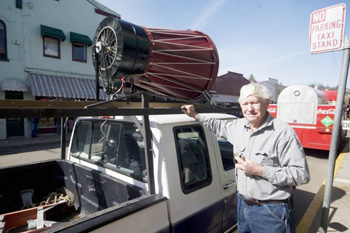New Wind Turbine Design Could Result in Fewer Animal Fatalities
 MIDDLESEX, Mass. — Wind turbines have proved to be a great way to produce energy, but there is usually a downside to every great creation. Installing these massive structures has led to the deaths of many avian creatures throughout the world.
MIDDLESEX, Mass. — Wind turbines have proved to be a great way to produce energy, but there is usually a downside to every great creation. Installing these massive structures has led to the deaths of many avian creatures throughout the world.
After realizing that animals, mainly birds and bats, were suffering and frequently dying as a result of the blades on wind turbines, 89-year-old World War II veteran and Jackson, Calif. resident Raymond Green, decided he needed to do something about it. Green has since entrusted his patented bird-safe wind turbine into the hands of Jerry Lynch, president of Middlesex, Mass.-based Sigma Design.
The new design, Catching Wind Power Compressed Air Enclosed Wind Turbine, does not have any exposed wind turbine blades, but instead consists of a cone encompassing the blade while still producing air compression. Green explains that unlike traditional three-blade turbines, which can kill birds and bats as they rotate at high speed, his prototype has no external moving parts, but instead has its blades safely encased within the semi-enclosed unit.
The patented “Inner Compression Cone Technology” makes it possible for the wind to draw in even though the blades are not exposed. Green claims his invention can produce double the output of a traditional wind turbine, even when placed closer to the ground.
The design is still in its initial phases and Lynch hopes that the wind turbine and Green’s unique approach will spark the interest in buyers.
“We hope that some visibility sends some people of interest our way, and that we can figure out a way to fund it,” said Lynch.
So far the company has been testing the product in order to give real numbers to interested parties and also work out any kinks the system may have. The testing is expected to take up to two years before the product potentially comes on the market.
“We just waited for a good windy day,” he said of the field-testing done by the company. “We collected some good preliminary data and put together a plan of what needs to be improved and done to commercialize this.”
 Before the large scale testing, Green had to come up with his own method in California. He attached his wind turbine prototype to the top of his Ford pickup and drove around his rural town, creating enough wind power to power a light bulb.
Before the large scale testing, Green had to come up with his own method in California. He attached his wind turbine prototype to the top of his Ford pickup and drove around his rural town, creating enough wind power to power a light bulb.
The new design has the potential to help many wind farms save the lives of avian creatures, especially at the Altamont Pass wind farm in Livermore, Calif. The area has one of the highest recorded wind turbine-related bird deaths in the U.S., and accounts for up to half of all wind farm caused bird fatalities in the country. The 31-year old wind farm is actually located in a bird migratory path and was constructed when the wind industry was just developing. As environmental groups have fought for new designs, they finally received somewhat of a relief in 2010 when a settlement was announced that would replace the old turbines with new, and less harmful turbines. The settlement will replace or shut down the outdated turbines by November 2015. The need for Green’s invention could prove useful and be welcomed in the area.
Environmental groups should be pleased with the technology as well, as many have fought for new designs in the past. Wildlife advocates have complained that between 1,700 and 4,700 birds are killed each year in the area, including the federally protected golden eagles and red-tailed hawks.
“…the question is, ‘what are the other energy companies doing and why is it taking so long…when repowering is a clear way to stop or reduce the bird kills?’” said Jeff Miller of the Center for Biological Diversity in a statement.
With a crucial need in the market, Green’s new Catching Wind Power Compressed Air Enclosed Wind Turbine could be the answer environmentalists have been looking for.
